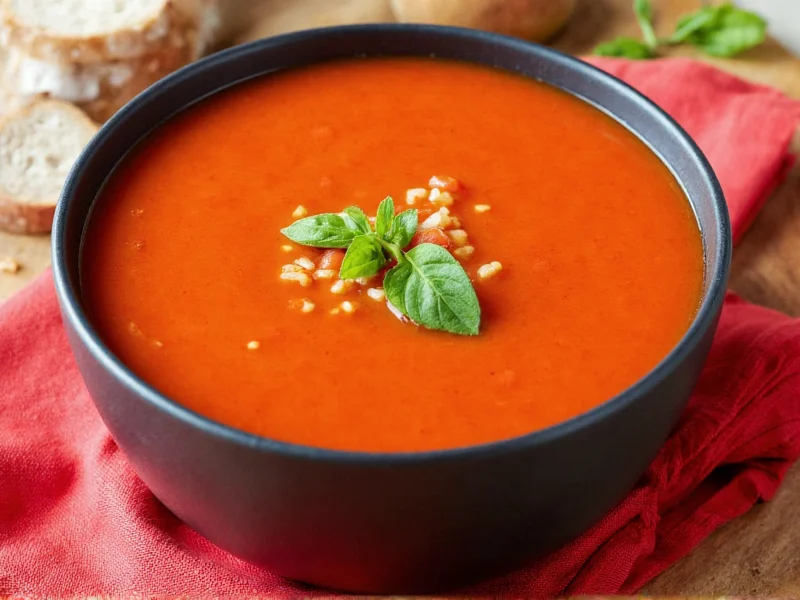Tomato soup remains one of the most beloved comfort foods worldwide, with roots tracing back to early 19th century recipes. Despite the \"tomato tomato soup\" phrasing in your query, professional chefs and culinary resources recognize only \"tomato soup\" as the standard term. The repetition likely stems from a typing error or autocorrect issue, as doubling ingredients isn't conventional in recipe naming.
Understanding Authentic Tomato Soup
True tomato soup starts with ripe tomatoes as the foundation, whether using fresh garden tomatoes in season or high-quality canned varieties during off months. The magic happens through proper technique—simmering tomatoes with aromatic vegetables like onions and garlic, then finishing with herbs that complement rather than overpower the natural sweetness of tomatoes.
Professional chefs emphasize that the best tomato soup balances acidity with natural sweetness. Many home cooks make the mistake of adding too much sugar, when instead, roasting tomatoes or adding a small amount of carrot can create more complex, natural sweetness without artificial taste.
Classic Homemade Tomato Soup Recipe
Creating exceptional tomato soup requires attention to ingredient quality and cooking technique. This foundational recipe serves as the basis for numerous variations:
- 2 lbs (900g) ripe tomatoes or 28 oz canned whole tomatoes
- 1 large yellow onion, diced
- 3 cloves garlic, minced
- 2 carrots, peeled and chopped
- 4 cups vegetable or chicken broth
- 2 tbsp olive oil
- 1 tsp fresh thyme
- 1 bay leaf
- Salt and freshly ground black pepper to taste
Preparation: Heat olive oil in a large pot over medium heat. Sauté onions and carrots until softened (about 8 minutes). Add garlic and cook for 1 minute until fragrant. Add tomatoes (with their juice if using canned), broth, thyme, and bay leaf. Bring to a simmer and cook for 25-30 minutes. Remove bay leaf, then blend until smooth using an immersion blender. Season with salt and pepper. For creamier texture, stir in 1/4 cup heavy cream or coconut milk before serving.
| Tomato Soup Variation | Key Ingredients | Preparation Time | Special Technique |
|---|---|---|---|
| Classic Tomato Basil | Fresh basil, balsamic vinegar | 35 minutes | Add basil at end to preserve freshness |
| Roasted Tomato | Roasted garlic, olive oil | 50 minutes | Roast tomatoes at 400°F for depth |
| Vegan Tomato | Coconut milk, nutritional yeast | 30 minutes | Use coconut milk instead of cream |
| Tomato Tortellini | Fresh tortellini, Parmesan rind | 40 minutes | Add tortellini in final 10 minutes |
Addressing Common Tomato Soup Challenges
Many home cooks encounter issues when preparing tomato soup. Understanding these problems helps create consistently excellent results:
Acidity Balance: Tomatoes naturally contain citric acid, which can make soup taste too sharp. Professional chefs recommend adding a small pinch of baking soda (1/8 teaspoon) to neutralize excess acidity, or incorporating naturally sweet vegetables like carrots or roasted red peppers.
Texture Issues: For perfectly smooth soup without a heavy cream base, pass your blended soup through a fine-mesh sieve. This removes any remaining tomato seeds or skin fragments that can create graininess.
Flavor Development: The secret to restaurant-quality tomato soup lies in layering flavors. Sauté vegetables slowly to develop sweetness, add tomatoes gradually, and allow proper simmering time for flavors to meld—never rush this process.
Nutritional Benefits of Homemade Tomato Soup
Preparing tomato soup from scratch offers significant advantages over canned varieties. Homemade versions contain higher levels of lycopene, the powerful antioxidant responsible for tomatoes' red color, which becomes more bioavailable when cooked with a small amount of healthy fat like olive oil.
A typical serving of homemade tomato soup (1 cup) provides approximately:
- 80-100 calories
- 2-3 grams of dietary fiber
- 40% of daily vitamin C needs
- 25% of daily vitamin A requirements
- Significant potassium and lycopene content
Unlike many commercial products, homemade tomato soup contains no preservatives, artificial flavors, or excessive sodium. You control the ingredients, making it easy to create low-sodium, gluten-free, or vegan versions that accommodate various dietary needs.
Perfect Pairings for Tomato Soup
The ideal accompaniments enhance rather than compete with tomato soup's bright flavor profile. Consider these professional pairing suggestions:
- Grilled cheese sandwiches: Use artisanal bread and high-quality cheese like sharp cheddar or gruyère for the classic combination
- Crusty bread: A baguette or ciabatta provides perfect dipping texture
- Simple green salad: A light vinaigrette-dressed salad balances the soup's richness
- Wine pairings: A medium-bodied red like Pinot Noir or a crisp white like Sauvignon Blanc complement tomato flavors beautifully
For an elevated dining experience, garnish your soup with fresh basil chiffonade, a drizzle of high-quality olive oil, or a dollop of pesto. These finishing touches transform a simple meal into something special without complicating the preparation.
Seasonal Adaptations for Year-Round Enjoyment
Tomato soup isn't just for winter! Adapting your recipe for different seasons ensures delicious results throughout the year:
Summer: When tomatoes are at their peak, use fresh, vine-ripened varieties. Add fresh herbs like basil or tarragon, and consider making a chilled tomato soup served with cucumber ribbons for hot days.
Winter: During colder months, roast your tomatoes and garlic first to develop deeper, caramelized flavors. Add warming spices like a pinch of red pepper flakes or smoked paprika for extra complexity.
Spring/Fall: Incorporate seasonal vegetables like asparagus in spring or roasted squash in fall to create transitional versions that celebrate what's fresh at the market.











 浙公网安备
33010002000092号
浙公网安备
33010002000092号 浙B2-20120091-4
浙B2-20120091-4